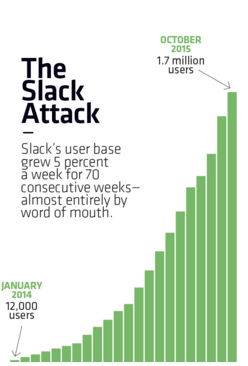The Slack Attack, Is Traditional E-mail Over?
E-mail, it’s a necessary evil, you have your work e-mail, personal e-mail and school e-mail, and then the e-mail you’ve had since you were 12 but refuse to delete, the list is exhaustive. For many of us seeing a notification “you have a new e-mail”, raises our blood pressure a tinge and immediately thoughts of urgent work matters race through our brain, demanding the e-mail be opened regardless if it’s important or not.
In 2013, over 100 billion emails were sent and received per day, it’s estimated to grow to 132 billion in 2017, this method of communication has been the most effective for much of the century in the workplace, it has become the commonplace way to get things done between colleagues in the corporate workplace.
Yet recently, a new messaging enterprise application, “Slack”, is trying to disrupt the environment with its unconventional every day replacement for email, IM and face-to-face meetings all in one place, and so far it’s succeeding in a stunning network diffusion. Slack’s approach to communication is attempting to deplete the stress around workplace e-mailing which often disrupts the work-life balance.
From January 2014, Slack had about 12,000 active users, but by October 2015 has acquired 1.7 million users, and this was achieved without a sales team for the software but simply word of mouth (it has only recently begun to advertise) . It is interesting to examine this growth of Slack at a rate of 5% for 70 consecutive weeks to the course topic on direct-benefits effect. This example provides a great picture of how a brand can establish a “trust” by direct benefit provided to users in using its technology in relation to those around them. It occurs when positive network feedback allows for the leading technology to grow more dominant, the noted efficiency of a compatible product user base in weighing the transition costs creates a greater payoff for those in a network using Slack.
Currently, “97% percent of new customers…[are] referrals”, people hear about how useful, and efficient Slack is from friends in the office, colleagues in different industries or are catching up to their own network’s niche of those already using. The noted growth from 12,000 users to 1.7 million users over the 70 weeks, shows the direct-benefit effect, where there is a “direct payoff” from copying the decision to use Slack from others in which it’s a more compatible technology in their network and provides an easier means of communication than an incompatible technology method, in this case the traditional e-mail.
Though, Slack hasn’t reached the equilibria of everyone choosing “Slack” as their method of practice for communication vs. traditional e-mail from providers of Google or Yahoo, it seems to be on the right track.
Seemingly this new tool for messaging is making collaboration with co-workers more simple and efficient, and this direct benefit is an enticing behavior to adapt. But in relative terms A being traditional e-mail and B being Slack, A is more enticing as a behavior and only takes a small fraction of neighbors to engage (from the start-up tech world), but if q is large, then the opposite is true: where B (Slack) is the attractive behavior and you need a lot of friends to engage in B before you switch to from A (e-mail).
Behavior A = 1/2
Behavior B = (1-p)
A is a better choice:
if p >= b/(a+b)
And: q = b/(a+b)
Thus, the cascading effect progress to an “equilibrium” of where everyone adopts A or B, yet in this case, Slack has only begun the cascade to where it still depends on if a person’s friends match a small q or a higher q, to determine their probability of switching.
Sources:
http://time.com/4090762/slack/
http://www.inc.com/magazine/201512/jeff-bercovici/slack-company-of-the-year-2015.html
http://www.fastcompany.com/3040638/tech-forecast/how-slack-uses-slack
http://misrc.umn.edu/workingpapers/fullpapers/2003/0319_051903.pdf

